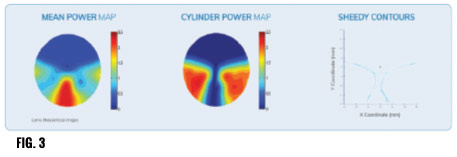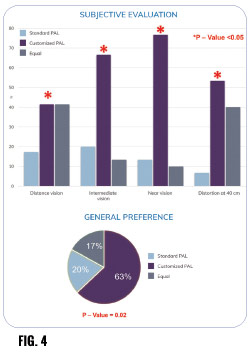Sponsored by IOT
By Deborah Kotob, ABOM
Real people wear lenses, and each one is a unique individual. Therefore, it is no surprise that in wearer trials, customized PALs were preferred over standard PALs. What I love about IOT is that they show comparisons of both objective and subjective data so that I can make an informed decision on what lens designs to offer. Switching patients from standard progressive design (molded or digitally surfaced) to the more costly customized free-form progressive design requires us to articulate the benefits with confidence. Wearer trials with data showing a clear preference for customized lenses over standard PALs give us added confidence in advanced lens design technologies. Consumers rely heavily on reviews to guide their purchases. Wearer trials are scientific reviews. Let’s see what the wearers had to say in the following excerpts from IOT’s Clinical Evaluation of Free-form PALs: Customized vs. Standard Designs, written by Concepcion P*, Cleva JM*, Chamorro E*, Crespo D*, García M*, Gago C*, Subero M*, Alonso J* *Indizen Optical Technologies S.L., Spain Corresponding author Pablo Concepción:

Customized PALs are calculated individually, taking into consideration the position of the lens in front of the eye according to the user physiognomy and the characteristics of the frame. The software uses different factors to optimize the oblique aberration for all gaze directions: refractive index, prescription, base curve, frame characteristics and the position of wear of each patient—interpupillary distance, fitting height, back vertex distance, pantoscopic angle, wrapping angle and near working distance (Fig. 1). This results in a power variation through the lens’ entire surface, depending on the user’s parameters, decreasing the oblique aberrations (Fig. 2). This reduction of oblique aberrations should lead to an improvement in the visual quality and satisfaction of the patients by the decrease of distortions, increase of image sharpness, blurriness reduction in the lateral areas of the lens and the increase of clear field width in the viewing zones of the progressive lenses. The main goal of this study is to analyze differences in visual perception and satisfaction rates between standard and customized PALs.
Two progressive addition lenses were designed ad-hoc for this study. Both designs showed similar power distribution maps (Fig. 3). However, PAL A (customized) was optimized considering personalization parameters. PAL B (standard) was optimized with a basic merit function that only considers prescription, frame size and pupil position.

STAGE I: OBJECTIVE EVALUATION
Distance visual acuity (VA) at on and off-axis viewing position was measured in high contrast (100 percent) in the wearer’s dominant eye. Objective visual performance on sport frames was tested because these frames have a significant wrapping angle, and therefore the lens is tilted with respect to the main direction of sight, producing a combination of prismatic effect and oblique aberrations that are usually stronger than in regular lenses.
STAGE II: SUBJECTIVE EVALUATION
After using two pairs of eyewear glasses for seven days each, patients were asked to select their preferred pair of glasses. Additionally, patients were asked to select the pair of lenses that provide them a better visual performance when doing some specific task: walking in the street, working in the computer, reading a book and seeing a grid at 40 cm. The subjective user perception difference when using personalized or non-personalized lenses was studied when using regular frames.

After seven days of use, the subjective evaluation showed a significant preference for customized lens design over standard design. When patients were asked to select their preferred design when doing several tasks, a statistical significant preference for the customized lens was obtained (Fig. 4).
CONCLUSIONS
Personalization of free-form PALs provides wearers better distance VA at off-axis viewing position as well as better subjective experience in terms of visual performance and comfort. After seven days of use, 63 percent of the users preferred the customized design.













